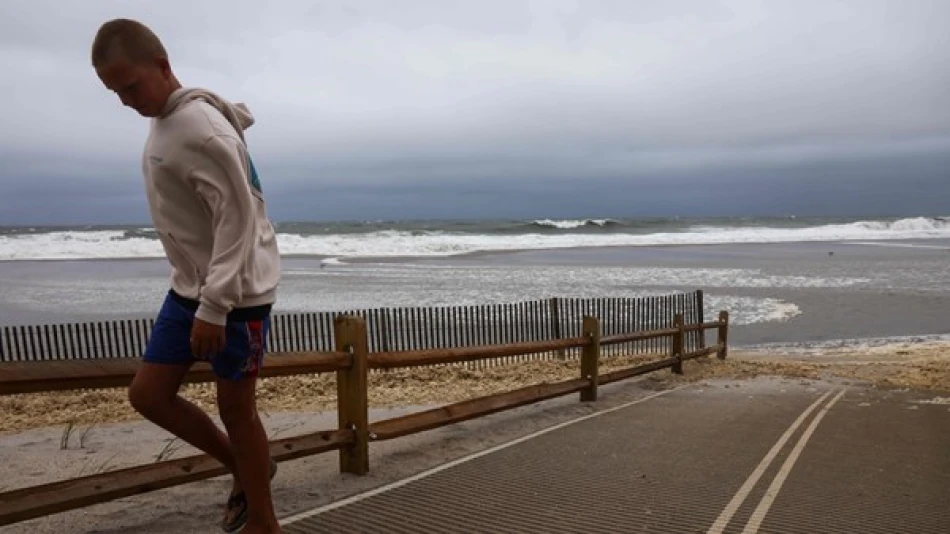
Devastating Floods Ravage Two US States in the Wake of Hurricane Irene's Onslaught
Hurricane Irene Exposes America's Coastal Vulnerability Crisis as Climate Change Amplifies Storm Impact
Hurricane Irene battered the coasts of North Carolina and Virginia with 105-mph winds and devastating storm surge, transforming vital transportation routes into impassable waterways and highlighting how rising sea levels are making even moderate storms increasingly destructive. The Category 2 hurricane represents the first major test of America's coastal defenses this Atlantic hurricane season, offering a stark preview of the compounding risks facing millions of Americans in vulnerable shoreline communities.
Immediate Devastation Across Mid-Atlantic Coast
Atlantic Ocean waves overwhelmed Highway 12, the critical lifeline connecting North Carolina's Outer Banks barrier islands to the mainland, rendering sections completely impassable. The iconic coastal route, which serves as the primary evacuation corridor for thousands of residents, disappeared beneath surging waters—a scenario that emergency planners have long feared.
Hatteras Island bore the brunt of Irene's fury, with traditional stilt-supported coastal homes suffering significant damage. Wind-driven sand buried streets and parking lots, while the storm surge tested the resilience of structures designed to withstand moderate flooding. These wooden-pile foundations, once adequate protection against occasional storms, now appear increasingly inadequate against the new reality of amplified coastal flooding.
The Climate Change Multiplier Effect
University of North Carolina professor Chip Conrad's assessment captures a troubling truth: coastal areas face a double threat that makes storms like Irene far more dangerous than historical precedent suggests. "Coastal areas are highly vulnerable to sea level rise because the land is slowly sinking while sea levels are rising significantly due to climate change," Conrad explained.
This phenomenon, known as relative sea level rise, means that even moderate Category 2 storms now pack the flooding punch of stronger historical hurricanes. The combination of subsiding land and rising oceans creates a compounding effect that traditional storm preparedness models fail to account for.
Rapid Intensification Patterns
Irene's development pattern reflects another concerning trend in modern hurricane behavior. The storm achieved peak intensity in just over 24 hours—a rapid intensification process that's becoming increasingly common as warmer ocean temperatures fuel explosive storm development. While Irene has since weakened, forecasters warn it could regain strength, demonstrating the unpredictable nature of storms in warming seas.
Economic and Infrastructure Implications
The flooding of Highway 12 represents more than a temporary inconvenience—it signals a fundamental challenge to maintaining critical infrastructure in an era of accelerating sea level rise. This coastal route supports tourism economies worth billions annually and serves as a hurricane evacuation route for barrier island communities.
Insurance markets are already pricing in these elevated risks, with coastal property premiums rising sharply across hurricane-prone regions. The Federal Emergency Management Agency's flood insurance program faces mounting pressure as payouts increase and the frequency of "once-in-a-century" flooding events accelerates.
A Preview of Future Challenges
As the first hurricane of the Atlantic season, Irene serves as an early warning system for coastal communities nationwide. The storm's ability to cause significant flooding and infrastructure damage while maintaining only moderate wind speeds suggests that traditional hurricane categories may no longer adequately convey flood risk.
Climate scientists project that sea levels along the U.S. East Coast could rise 1-4 feet by 2100, with some areas experiencing even greater increases due to land subsidence. This means storms of Irene's strength could routinely produce flooding that historically required much stronger hurricanes to generate.
The National Hurricane Center's warning against swimming along "the majority of East Coast beaches due to life-threatening waves and currents" underscores how Irene's influence extends far beyond its immediate path, affecting coastal conditions across hundreds of miles of shoreline.
 Layla Al Mansoori
Layla Al Mansoori







